- Updated on April 4, 2024
![]() By Dr. Artour Rakhimov, Alternative Health Educator and Author
By Dr. Artour Rakhimov, Alternative Health Educator and Author
- Medically Reviewed by Naziliya Rakhimova, MD
Edited by J diFeliciantonio on February 19, 2020.
Earthing Methods: How to Ground Yourself for Better Health

Electrically connecting your body to the Earth — known as “grounding” or “Earthing” — can quickly create positive changes in your health, particularly in your breathing.
But how to start?
Below I discuss simple, practical tools and techniques you can use ground yourself throughout the day (and night). In fact, most people can find nearly all required materials already in their households.
It’s important to note that the soles of the arms and feet are the most conductive surfaces on the human body. Thus, it’s best to connect any grounded patches, wires, mats, etc. to these areas of the body.
Warning: Excessive grounding, for people who are infrequently grounded and/or currently sick, can trigger a cleansing reaction, which can potentially be dangerous. Therefore, similar to breathing retraining, before incorporating grounding into your lifestyle, it’s smart to review the restrictions and contraindications in Module 9 of this course.
Let’s begin.
 How to ground yourself during the daytime
How to ground yourself during the daytime
There are many ways you can Earth, whether at work or at home.
1. Barefoot walking or running on soft grass or dirt is the easiest and cheapest option. If you are new to barefoot activity, for the first few weeks, use this method before sunset (before 6 pm, or even 2 pm if you find you’re sensitive to grounding), since sudden excessive stimulation of nerve endings of the feet can make it difficult later in the evening to sleep.
One effective approach is to Earth on soft grass 30 to 60 minutes in the early morning when the grass is still wet (making it more conductive).
2. You can also ground yourself using a simple do-it-yourself device (shown below). This cheap, homemade device can be used only in the USA and Canada, since it is made for a US-style three-prong outlet. (If you are located in a different country, study the details provided further below.) All parts can be found in a hardware store.
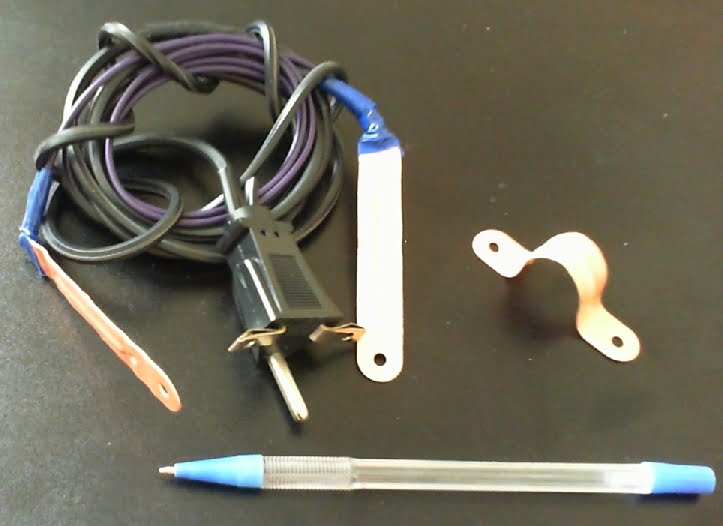
In order to make this grounding appliance, you need:
– electrical cable
– 2 copper-clad clamps (1 clamp is also sufficient)
– 1 standard three-prong plug
– electrical tape.
In order to get two grounded copper pieces, you’ll need to connect two wires, creating a split. Stripping back any insulation that’s in the way, connect the wire off the plug to the middle of the second wire with the attached copper-clamp ends. (If you are fine with just one grounded copper piece, no need for two wires; you can simply attach a copper clamp to the other end of the plug wire.) Use electrical tape to secure any connections.
If you happen to use a plug and cable from an old electrical appliance, keep in mind that the ground wire/prong is located in the middle.
Very important: As shown in the appliance photo above, the plug’s 2 upper flat prongs should be bent for safety reasons, leaving only the middle round prong left to plug in for grounding use.
Of course, you can always get electrically connected (i.e., grounded) to the Earth using any copper cable. (Other types of electrical cables can be used, too.) What’s important is that one end of the wire is embedded sufficiently deep in the ground (at least one meter), and the other end is connected to your body. The best type of ground for Earthing is moist soil. Rocky earth will also do, but grounding into dry sand requires burying the wire much deeper, as sand is not so conductive. (If you’re in a sandy area, you can check with an electrician about how far down exactly you should bury your ground wire.) Some people even “water” their grounding appliance daily for optimum conductivity!
Again, it’s best to keep the electrodes (copper pieces of the grounding device) on the soles of your feet. An easy way to do this is to slide the electrodes into your socks (in between the bottom of your feet and socks), or attach them to a pair of sandals (as long as the copper is in contact with your feet). Some people like to wear the electrodes on their waist, but in my opinion, this is less preferable due to the superior conductivity of the soles.
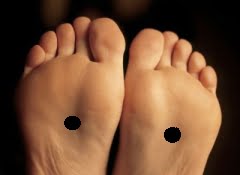 More specifically, the flat copper pieces can be attached to your K1 (Kidney 1) acupuncture points (see the picture to the right). These are probably the most conducive places on the skin of the whole body. Surgical tape can be used to fix the copper pieces onto K1 for a better connection.
More specifically, the flat copper pieces can be attached to your K1 (Kidney 1) acupuncture points (see the picture to the right). These are probably the most conducive places on the skin of the whole body. Surgical tape can be used to fix the copper pieces onto K1 for a better connection.
3. A footbath with salty water, is another great way to ground. To do this, fill a wide footbath basin with 2 to 3 liters of water. Add 2 to 3 tablespoons of sea salt and stir to dissolve. Using a cable with copper electrodes on both ends, keep one electrode in the water and the other one grounded to the the Earth.
If you don’t have any contraindications, you can use this method 2 or 3 (or more) times per day. The footbath provides nearly an ideal connection between Earth and the body, as it grounds the entire surface of the feet.
Grounding the body during sleep
Earthing during sleep is highly suggested, especially for those people who have low morning CP results (that is, low morning body-oxygenation test). Like with any grounding appliance, one end of the grounding cable should be connected to Earth; the other end should preferably connect to some object that will stay in contact with your body while you sleep, even if you move around.
Where can I attach the grounding end?
If it’s not possible to attach your Earthing appliance directly into the ground (e.g., if you live in a high rise building), there are other ways to make the connection, depending on your current location and the availability of plumbing and heating tubes.
 1. If your home or office’s electrical sockets are connected to a ground cable (i.e., one that goes down into the Earth), you can plug your device into one of these electrical sockets. The left picture shows what this looks like in the USA and Canada.
1. If your home or office’s electrical sockets are connected to a ground cable (i.e., one that goes down into the Earth), you can plug your device into one of these electrical sockets. The left picture shows what this looks like in the USA and Canada.
2. If you are located in the UK or Ireland, you can disassemble the plug (usually you need to unscrew one or more bolts to do this), so that you plug only the upper-middle prong into the grounded socket. You can do the same in other countries where electrical outlets are grounded to Earth.
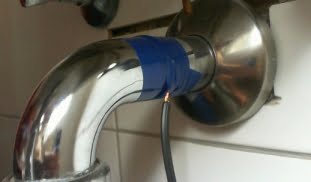 3. If you live in continental Europe, you can connect ground wires to plumbing or central heating tubes. (In fact, this can be done anywhere in the world where plumbing is conductive and grounded.) As shown in the image on the right, the copper part of the cable was separated from its plastic coating (this can be done using ordinary scissors); the exposed copper was then fixed in place with electrical tape. (Other types of tape may also be used.) The crucial thing is to make good contact between the metal wire and metal plumbing. Also, make sure that your cable is attached to pure metal that is not painted, as generally paints are nonconductive.
3. If you live in continental Europe, you can connect ground wires to plumbing or central heating tubes. (In fact, this can be done anywhere in the world where plumbing is conductive and grounded.) As shown in the image on the right, the copper part of the cable was separated from its plastic coating (this can be done using ordinary scissors); the exposed copper was then fixed in place with electrical tape. (Other types of tape may also be used.) The crucial thing is to make good contact between the metal wire and metal plumbing. Also, make sure that your cable is attached to pure metal that is not painted, as generally paints are nonconductive.
Earthing devices and electrodes for body contact
1. As reviewed above, simple do-it-yourself devices with grounded copper pieces can be used to Earth during sleep. Wear socks to bed, and keep the device’s electrodes in the socks. Optionally, you can use surgical tape to keep the copper pieces attached to the K1 points on your feet.
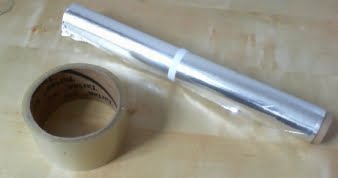 2. Sleeping on metal conductive tape, attached to your bed linen and connected to a ground, is another way to Earth the body. However, such conductive tapes can be usually be found only in specialty electrical stores. Here is a similar solution on how to ground yourself, but using materials found in many homes.
2. Sleeping on metal conductive tape, attached to your bed linen and connected to a ground, is another way to Earth the body. However, such conductive tapes can be usually be found only in specialty electrical stores. Here is a similar solution on how to ground yourself, but using materials found in many homes.
Ordinary aluminum foil (like the kind used for baking) and wide plastic tape (or duct tape, or blue tape) can easily be used to make a metal grounding strip. (See image on left.)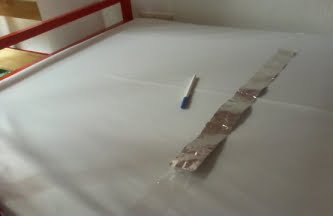
How? Attach about 50-60 cm (20-24 in.) of aluminum foil to the sticky side of the tape. Next, fix this metal strip in the middle of your bed (as shown on in the image on the right).
Important: Make sure the uncovered metal part is facing up, so that your skin can touch it during sleep.
Warning: Do not use foils from potato chip bags and similar food wrappings. Both sides of such foils are usually covered with a thin (invisible) layer of plastic, which prevents the flow of electrons (i.e., electrical current) needed for grounding.
After your metal strip is in place, you can connect it to the end of a grounded copper wire. It’s best to use electrical tape to do this, as other tapes can be too sticky.
These are not the only ways to ground yourself. Grounded mats, patches, etc. are also available online.
But which methods are best?
Earthing efficiency depends on:
– total body surface area that is grounded;
– skin conductivity of this area (or resistance);
– duration of grounding.
One positive effect for sick people, is that while grounding they tend to have stronger perspiration, which increases the conductivity of their skin. As a result, they get more electrons when grounding.
Warning: Do not use grounding devices during thunderstorms, due to possible lightning strikes. In the long run, personal safety can be increased with the application of one trick that is used for nearly all commercial electronic devices. This trick and its exact parameter is provided here below as your bonus content.
You need to add a 100 km resistor to your electrical circuit and blow-up fuses to prevent (the already minuscule) chances of electrocution due to lightning.
[/sociallocker]
Warning: People with serious health problems, those taking certain types of hormones and other medical drugs, pregnant women, and people with transplants need to exercise caution while grounding and be aware of temporary restrictions and contraindications.
How many hours per day should I ground myself?
The body’s Earthing requirements depend on many factors. Some people are fine with only 1 to 2 hours grounding per day, while some need more (for example, 6 to 8 hours during sleep). Others report that they get optimum benefits when grounded 24/7. The collective experience of our breathing students shows that the need for Earthing increases when the CP (the body oxygen test) is low and inflammation is high. Observations about this relation between CP and Earthing needs are discussed in the bonus content below.
Those who are really sick, inflamed, and have less than 20 secs. CP — actually, who can even have less than 12 secs. daily CP and less than 8 secs. in the morning — may need to ground 10 to 20 hours per day, or even 24/7. As morning CP increases, inflammation reduces, and disease becomes more mild, 1 to 2 hrs. grounding is usually enough to achieve reasonably normal health. That said, I have taught students with 50 to 60 secs. morning CP and 4 to 4.5 hrs. of natural sleep, and still they find grounding useful during the day and while sleeping.
[/sociallocker]
Earthing Methods: How to Ground Yourself for Better Health
If you find Earthing beneficial, you can investigate more about this topic. You can also look to purchase commercial grounding products. The most popular and effective Earthing product is this (paid link – commissions earned) grounding mat.
In this video, Earthing and Barefoot Walking, Dr. Artour Rakhimov explains how grounding was introduced into the NormalBreathing.com course, and why Dr. Buteyko advised barefoot walking as a part of breathing retraining.
A great book about Earthing, and more information
 The image on the right links to the most popular book on Earthing (paid link – commissions earned): Earthing: The Most Important Health Discovery Ever? by Clint Ober. This book is available on Amazon in paperback, Kindle, or MP3 audio format.
The image on the right links to the most popular book on Earthing (paid link – commissions earned): Earthing: The Most Important Health Discovery Ever? by Clint Ober. This book is available on Amazon in paperback, Kindle, or MP3 audio format.
If you’re interested, you can also read more (on this website) about grounding’s effects on inflammatory response and chronic inflammation.
For a university review of clinical studies related to the effects of Earthing, go here: “Earthing: Health Implications of Reconnecting the Human Body to the Earth’s Surface Electrons.”

